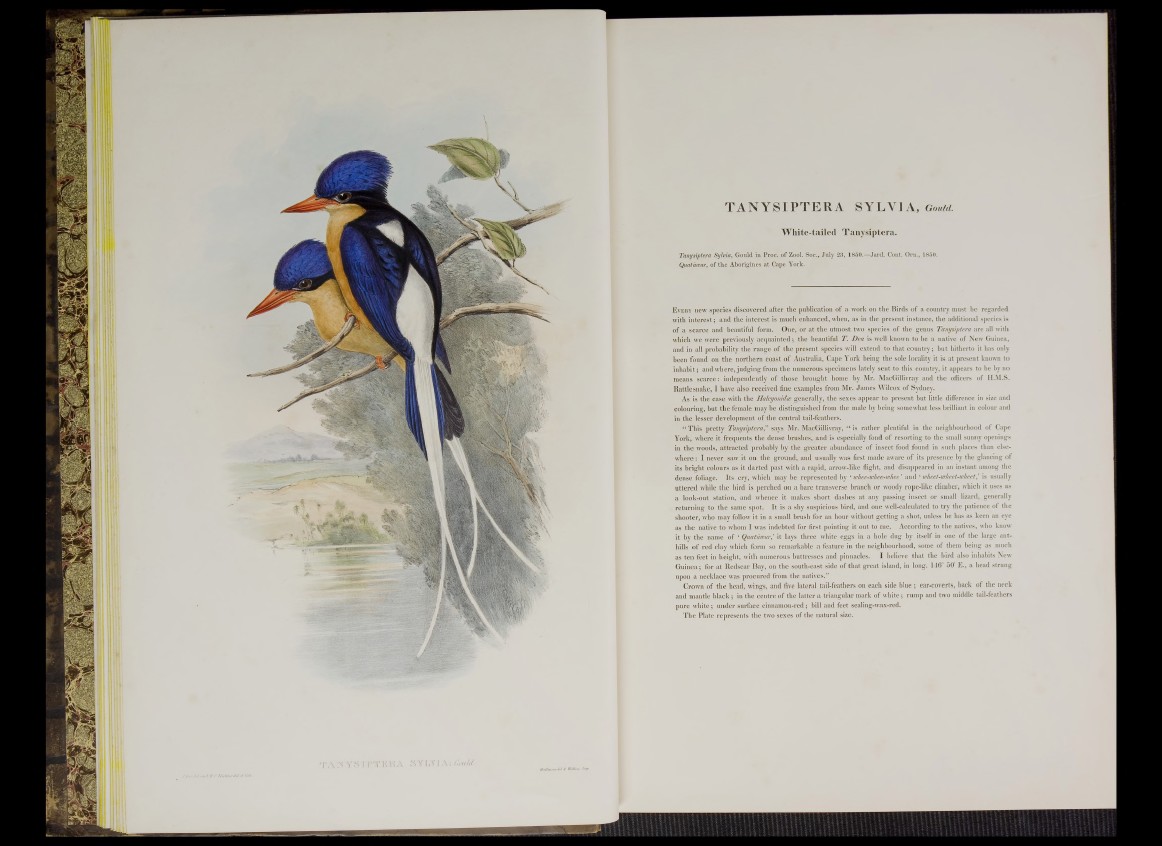
TANYSIPTERA SYLVIA, Gould.
White-tailed Tanysiptera.
Tanysiptera Sylvia, Gould in Proc. of Zool. Soc., July 23, 1850.—Jard. Cont. Ora., 1850.
Quatawur, of the Aborigines at Cape York.
E very new species discovered after the publication of a work on the Birds of a country must be regarded
with interest; and the interest is much enhanced, when, as in the present instance, the additional species is
of a scarce and beautiful form. One, or at the utmost two species of the genus Tanysiptera are all with
which we were previously acquainted; the beautiful T. Dea is well known to be a native of New Guinea,
and in all probability the range of the present species will extend to that country; but hitherto it has only
been found on the northern coast of Australia, Cape York being the sole locality it is at present known to
inhabit; and where, judging from the numerous specimens lately sent to this country, it appears to be by no
means scarce: independently of those brought home by Mr. MacGillivray and the officers of H.M.S.
Rattlesnake, I have also received fine examples from Mr. James Wilcox of Sydney.
As is the case with the Halcyonidce generally, the sexes appear to present but little difference in size and
colouring, but the female may be distinguished from the male by being somewhat less brilliant in colour and
in the lesser development of the central tail-feathers.
“ This pretty T a n y s ip te ra says Mr. MacGillivray, “ is rather plentiful in the neighbourhood of Cape
York, where it frequents the dense brushes, and is especially fond of resorting to the small sunny openings
in the woods, attracted probably by the greater abundance of insect food found in such places than elsewhere
: I never saw it on the ground, and usually was first made aware of its presence by the glancing of
its bright colours as it darted past with a rapid, arrow-like flight, and disappeared in an instant among the
dense foliage. Its cry, which may be represented by ‘ whee-whee-ivhee ’ and ‘ wheet-wheet-wheet,’ is usually
uttered while the bird is perched on a bare transverse branch or woody rope-like climber, which it uses as
a look-out station, and whence it makes short dashes at any passing insect or small lizard, generally
returning to the same spot. It is a shy suspicious bird, and one well-calculated to try the patience of the
shooter, who may follow it in a small brush for an hour without getting a shot, unless he has as keen an eye
as the native to whom I was indebted for first pointing it out to me. According to the natives, who know
it by the name of ‘ Quatawur,’ it lays three white eggs in a hole dug by itself in one of the large anthills
of red clay which form so remarkable a feature in the neighbourhood, some of them being as much
as ten feet in height, with numerous buttresses and pinnacles. I believe that the bird also inhabits New
Guinea; for at Redscar Bay, on the south-east side of that great island, in long. 146° 50' E., a head strung
upon a necklace was procured from the natives.”
Crown of the head, wings, and five lateral tail-feathers on each side blue; ear-coverts, back of the neck
and mantle black; in the centre of the latter a triangular mark of white; rump and two middle tail-feathers
pure white; under surface cinnamon-red; bill and feet sealing-wax-red.
The Plate represents the two sexes of the natural size.